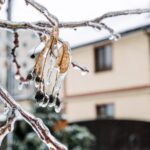
Throughout the winter season, snow and ice are common problems across many states. Even if clearing the streets is generally the responsibility of the municipality, there are often local guidelines mandating swift removal of snow and salting icy areas on sidewalks and other pathways to reduce the risk of accidents.
Property considerations
If your rental property is an apartment or multi-housing unit, you are likely responsible for clearing snow and ice in common areas such as stairs and walkways.
When it comes to a single-family property, the guidelines are less clear and vary between states and even cities within the same state. In some cases, the city or neighborhood clears ice and snow from the sidewalks. In others, this is the responsibility of the property owner.
In all cases, it’s important to do so as quickly as possible as liability for falls and injuries is a real risk.
Lease language
To ensure that both the tenant and the landlord are clear on who is responsible for what, there are some key clauses to include in the lease, including but not limited to:
- Who is in charge of snow removal and ice mitigation
- Where the snow should be removed from
- Where the snow should be moved to
- How quickly the snow should be removed; this will vary by city so be sure to check with your local city government.
- If your tenant is tasked with the responsibility, if you choose to provide snow clearing equipment or if tenants should provide their own
It should also be noted that liability may fall on you regardless of what is stated in the lease. Always be sure to check both state and local laws to ensure that your lease aligns with legal guidelines.
Winter maintenance
Cold weather, regardless of snow, can cause damage if not handled properly.
Before temperatures really dip, it is a good idea to visit the property and check on key systems and equipment such as the heating, water pipes, smoke alarms, and carbon monoxide detectors. Ensuring that all equipment is in good working order before the season gets underway can reduce the risk of failures and early-morning emergencies.
You should also regularly check the seals on external doors and windows to ensure they are being maintained properly and are in good condition. Not only can old or broken seals damage the property if water and ice get in, but it can also impact the overall temperature of the property and put a strain on heating systems.
In addition to your regular maintenance, you may wish to discuss ways in which your tenants can look after the property during the colder months such as best practices for using the heating system or how to avoid frozen pipes.
Remember, always check your local laws and ensure that you are following them. In addition to legal requirements, helping your tenants maintain the property throughout the winter months may reduce the risk of long-term damage.



